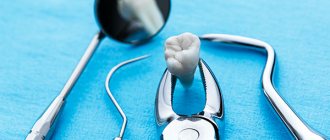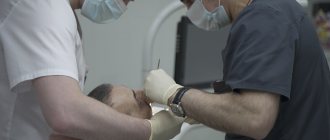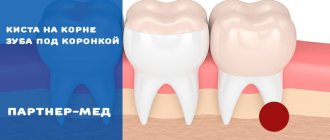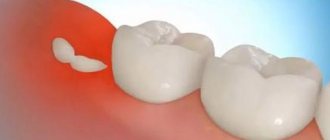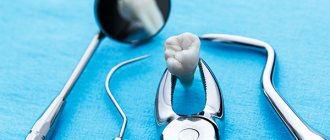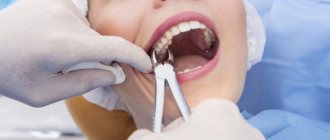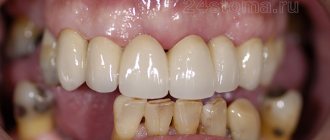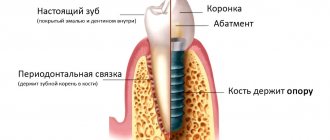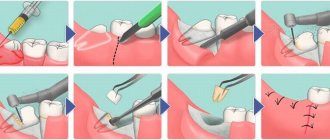In the last century, when asked whether it is painful to remove the root of a tooth if the crown is completely destroyed, many dentists would have given an affirmative answer. Pain during and after the procedure, complications from anesthesia and discomfort plagued many patients. But today the situation has changed - a sick tooth and its root can be pulled out absolutely painlessly
.
Indications and contraindications for molar tooth extraction
Reasons for removing a molar tooth may be:
- purulent periostitis;
- abscess;
- phlegmon;
- large tumor in the tooth area;
- purulent periodontal disease;
- the presence of a cyst in the area of the diseased tooth;
- exposed pulp;
- longitudinal tooth fracture;
- critical tooth decay;
- critical tooth curvature;
- disease of the dental bone tissue;
- sinusitis.
The following reasons are contraindications to the removal of molars:
- acute heart diseases;
- acute viral diseases;
- flu;
- angina;
- renal failure;
- pancreatitis;
- hepatitis;
- acute diseases of the nervous system;
- oncological diseases
- initial and final stages of pregnancy;
- stomatitis;
- gingivitis
- general degeneration of the body;
- alcohol poisoning.
How to pull out the remaining root in the gum
It is always easier for a dental surgeon to remove the entire tooth than just the remaining root parts.
First, the doctor carries out diagnostic measures, which include:
inspection;- reorganization;
- taking pictures.
If he deems it necessary, he may ask the client to take a blood test. On the appointed day, the patient is given an anesthetic. Local anesthesia is usually sufficient. When the anesthetic takes effect, the hard fragments are removed using special forceps. When the gums are completely overgrown, they are first excised, and the bone tissue is drilled out to gain access to the root zone. After this, using a dental elevator, all detected particles of the missing unit are removed. Such an operation is certainly complex and traumatic. Upon completion, stitches are applied.
Molar removal technology
Before proceeding with the removal of a molar, the doctor must make sure that there is no curvature of the roots. For this, an x-ray is taken. If the roots are not bent, the patient is given an anesthetic injection. After 10 minutes, the tooth can be removed.
First, the dentist carefully separates the gum from the body of the tooth. Then he grabs the tooth with pliers and begins to swing it and rotate it at the same time. After several such manipulations, the doctor pulls the tooth out of the alveoli.
In this sequence, both the upper and lower root teeth are removed. However, it is somewhat more difficult to grasp the upper molars with forceps.
Sometimes, when removing a molar, the doctor must first cut it into two or three parts and then pull out each part separately. This usually happens when the roots are bent.
In case of severe curvature of the roots, when they intertwine with the roots of neighboring teeth, removal must be done in fragments and under general anesthesia. In this case, the doctor completely exposes the gum around the diseased tooth.
If there is a cyst in the area of a diseased molar, the doctor is required to be highly qualified. This removal is done under both local and general anesthesia.
Two days after the removal of a molar, the patient must visit the dentist again to take an x-ray. This is necessary to ensure that all tooth roots have been removed.
Possible complications
If your tooth hurts after extraction, don’t be surprised. However, in this case, we can rather talk about the fact that the gums hurt after tooth extraction. This is a fairly common complication that many people experience. The severity of pain varies from tolerable to severe. In the latter case, it would be advisable to take painkillers. The most optimal is to use the drug Ketanov, which can relieve even the most severe pain.
Another common complication is infection. The hole after tooth extraction is a vulnerable place into which dangerous microbes can easily enter. As a result, alveolitis often develops. In this case, it is necessary to take antibiotics for some time and visit the dentist for local treatment of the hole.
It is important to remember that the antibacterial drug cannot be taken independently; only a doctor can prescribe it accordingly.
Is it painful to remove molars?
Today, only older people remember the terrible pain during the removal of molars. Nowadays, the quality of painkillers is so high that the patient does not feel pain at all, even with difficult removal. At the same time, after the anesthesia wears off, pain, of course, occurs, but it is quite tolerable and depends on how much the gum under the tooth was disturbed.
If the pain is still severe, then the dentist recommends taking a painkiller tablet. The same analgin successfully dulls pain for a long time.
In rare cases, the patient may experience throbbing and increasing pain. This annoying phenomenon occurs due to inflammation of the socket. If measures are not taken quickly, the tissue begins to fester in the hole. This process can be suppressed with drug treatment, but sometimes you have to open the gum and clean the hole from pus.
Can the root “come out” on its own?
Fearing surgical removal of the tooth root and the associated discomfort, some hope that the dental fragments will leave the gums on their own. Such people walk around for years with bone remains decomposing in their mouths, which are breeding grounds for infections and contribute to the appearance of an unpleasant odor. The root can actually come out on its own, but this rarely happens.
More frequent scenarios:
- deposition of a large amount of hard plaque on it and irritation of the soft surrounding tissues;
- overgrowth of the gums and the appearance of an acute inflammatory process (subsequently, surgery has to be performed to solve this problem).
Sometimes a rotten maxillary root causes an infection that spreads directly to the maxillary sinuses. If it is in the bottom row, the patient may encounter osteomyelitis - a purulent-necrotic process that develops in the bone.
Removal of molars during pregnancy
Let us say right away that any surgical intervention during pregnancy is extremely undesirable. If a molar tooth hurts at this time, then ideally it would be best to simply heal it. Unfortunately, sometimes this is no longer possible and the diseased tooth has to be removed.
It is highly undesirable to remove molars in the first and last months of pregnancy. It is at this time that the fetus is most vulnerable.
If it is possible to postpone the removal of a molar until the birth of the child, then this is exactly what should be done.
Under no circumstances should you hide your pregnancy from your dentist. On the contrary, this should be said immediately. In this case, the doctor will select a harmless anesthetic that will not cross the placental barrier.
If a pregnant woman is facing a complex molar tooth extraction, then this should only be done in a hospital setting. After removal, the patient should be under medical supervision for at least two to three days. This is due to the fact that very often, after the removal of a molar, pregnant women experience a sharp increase in body temperature, and this is extremely harmful for the fetus.
What to do after deletion
After any surgical intervention, you should follow all the dentist’s recommendations, as well as:
- do not eat for 2 hours after the procedure;
- cool the soft tissues of the face in the projection of the removed root;
- stop smoking for two days;
- take prescribed pain medication;
- make antiseptic applications;
- watch to see if other teeth are crumbling.
Sometimes after complex extractions, dentists prescribe antibiotics to patients.
This appointment cannot be ignored - after a tooth is pulled out of the socket, a focus of infection forms in it, which can only be extinguished with the help of medications.
The following video schematically shows different methods for removing incisors, canines, molars and premolars of the lower and upper jaw.
Molar tooth extraction in children
Unfortunately, young children often develop diseases in both their primary and permanent molars. Worse, it is not always possible to heal them. Dentists remove permanent teeth for children only when there is no way to save them.
Primary molars are both treated and removed. If a permanent tooth begins to grow under a baby molar, then the baby tooth is always removed, since it interferes with the normal formation of the permanent tooth.
At the same time, dentists never agree to premature removal of baby molars. Such teeth are sure to heal. If you remove a baby tooth ahead of schedule, then the baby will develop a crooked bite.
There are situations when a child’s molar tooth must be removed. Such situations include:
- molar root cyst;
- presence of granuloma;
- inflammation of the tooth root;
- inflammation of the nerve of the lower jaw;
- severe destruction of the integrity of the tooth.
Amputation of a part
It is not always necessary to remove the entire root. In certain situations, the doctor may decide to perform an amputation. This operation involves removing only part of the hard tissue located deep in the gum. Their healthy fragments remain intact. The space that remains after removing the elements is filled with a special osteoplastic mass. Due to this, the unit continues to be securely held in the dentition and hardly becomes loose. Amputation is only relevant if the crown is in satisfactory condition. If it is absent, there is no point in such treatment, since a partially preserved root cannot be considered as a durable support for a prosthesis or bridge.
Is it possible to remove a molar tooth yourself?
Trying to remove a molar tooth yourself is extremely dangerous. The only exception is very severe tooth looseness. It should be borne in mind that complete removal even in this situation will not work. You will simply break off the body of the tooth from the root, and nothing more. In any case, after such an independent removal, you need to visit a dentist, who will determine what should be done next. Sometimes an artificial tooth is installed at the root, and it can last for more than one year. If the root has defects, then it has to be removed.
There are situations when you have to remove a child’s very loose baby tooth at home. In this case, you should thoroughly brush the baby’s teeth and disinfect the oral cavity. Then you should wrap your fingers in sterile gauze, loosen the tooth thoroughly, and only then try to pull it out. If this was not possible on the second attempt, then the child must be taken to the dental clinic in any case.
If you have successfully removed the tooth from the socket, then you must firmly place a gauze swab in the socket and leave it there for 30 - 40 minutes. In the next two hours, the child should not be allowed to eat or drink.
Even if the removal was successful, the baby still needs to be shown to the dentist. This is the only way to protect your child from possible complications.
Wisdom teeth extraction
You can remove a wisdom tooth if you can loosen it and grab it tightly with your fingers. Place a cotton swab in front of the cheek on the area of the problem tooth. These teeth have long roots, making it almost impossible to remove them yourself. Tooth extraction requires a careful approach, but it is equally important to avoid future infection.
For this:
- Provide the empty hole with maximum peace;
- Brush your teeth, but be careful not to wash away the clot that has formed;
- To improve blood circulation in the injured area, apply warm, damp compresses to the gums;
- Rinse your mouth after every meal;
- Stick to a diet - hot and cold foods should be excluded;
- Use painkillers only when absolutely necessary, avoiding overdose.
Removal methods without pain
To ensure that the removal of problematic eighth molars is painless, dentists have a number of anesthetic drugs that are selected depending on the clinical situation. Previously, extraction was carried out using the drug Novocain, which was a good pain reliever and was considered a low-toxic substance. However, during the tests, a large number of various complications after its use were confirmed, from allergic reactions to anaphylactic shock.
Anesthesia for wisdom tooth removal
Today, there are much more effective and safe drugs that allow extraction to be carried out quickly and painlessly. Lidocaine is also a common drug - it is used in most budget dentistries; the drug shows good results in pain relief, which are several times higher than those of Novocaine.
There is rarely an allergic reaction to the product, however, during prolonged manipulations, doctors have to administer a large dose of the substance from 3 to 10 ml. To administer Lidocaine, plastic syringes with not very sharp needles are used, which is why the patient feels severe pain after the operation. This explains the fact why it is painful to swallow after extraction, and the discomfort intensely radiates to the ear and throat.
To avoid pain and discomfort for the patient during removal, dentists give preference to articaine drugs, such as Ultracaine, Septanest, Ubistezin
They are administered using carpule metal syringes, the ampoule does not need to be opened, contact with air is excluded, and the dose of adrenaline intended to extend the freezing period is precise. This reduces to zero the risk of complications such as rapid heartbeat, dizziness and panic. For weakened patients, disabled people, pregnant women and adolescents, Scandonest injections are more suitable - this drug does not cause vasodilation and does not contain adrenaline.
Popular questions
- What are the features of the operation in the presence of overgrown periodontal tissue?
Tooth root overgrown with gums
The manipulation is carried out under general anesthesia by a surgeon in the presence of an anesthesiologist. First, gum resection is performed, opening access to the root and its canals. Afterwards, the root is extracted with a special instrument and the alveoli are treated with medication.
- What kind of doctor does this?
The surgical intervention is performed by a dental surgeon. If necessary, other specialists may be involved in a consultative examination.
- Do roots with caries need to be removed or treated?
The appropriateness of treatment for this pathology is determined by the dentist in each case individually based on the results of an x-ray examination. The main indication for extraction of the root of a tooth affected by caries is its damage by more than 50%. In other cases, treatment is carried out by installing an inlay and a special artificial crown.
- How to remove a cyst on the root of a tooth? Granuloma?
Removal of a cyst or granuloma is carried out through surgery. For this, depending on the indications, the following techniques are used: cystectomy, hemisection, cystotomy, laser extraction. In the presence of purulent exudate, after opening the granuloma, drainage is performed.
- Is it necessary to remove the roots of baby teeth?
It is not recommended to remove the roots of baby teeth. To carry out this manipulation, significant evidence is required. Experts include severe carious tooth decay, advanced stage of periodontitis, pulpitis or fistula on the gum, the formation of a cyst on the root of the tooth, as well as inflammation and rapid infection.
- What technique is used to extract a pin from a tooth root?
This manipulation is carried out using ultrasound. Under its influence, it is possible to carefully loosen the structure without damaging the natural tissues of the hidden part of the tooth.
- Why is my cheek swollen after this procedure?
The main reasons include: the complexity and high trauma of soft tissues during surgery; development of an inflammatory process or suppuration; unprofessional root extraction, the body’s reaction to certain medications; the appearance of a hematoma due to fragile capillaries.
- How is tooth root extraction done from the maxillary sinus?
First of all, perforation of its bottom is carried out, followed by endodontic treatment. Thanks to this technique, the hard tissues of the hidden part of the tooth are gently exposed during its extraction.
Features of tooth root extraction in different jaws
There are slight differences in the methods and types of instruments used for manipulation on different jaws.
On the top, bayonet-shaped forceps are used to extract molars. C-shaped dental pliers are used to extract incisors and canines. For these purposes, rotational movements are carried out with pliers, which ensures minimal damage to the periodontal tissues. If it is impossible to extract the tooth root with dental pliers, then a drill is used.
The rejected root is removed after preliminary sawing the bottom of the tooth cavity. After using a drill with a ball-shaped tip, the necessary cavity is created in the inter-root commissure for longitudinal sawing of the bottom of the tooth with a furssor drill. Next, in the prepared cavity, using an elevator and bayonet-shaped dental pliers, the palatal root is dislocated.
The procedure for removing roots on the lower jaw is much simpler. For these purposes, as a rule, dental pliers with curves along the edge and with thin and narrow cheeks are used. Extraction of the roots of wisdom teeth is carried out by surgeons with the additional use of an elevator.
